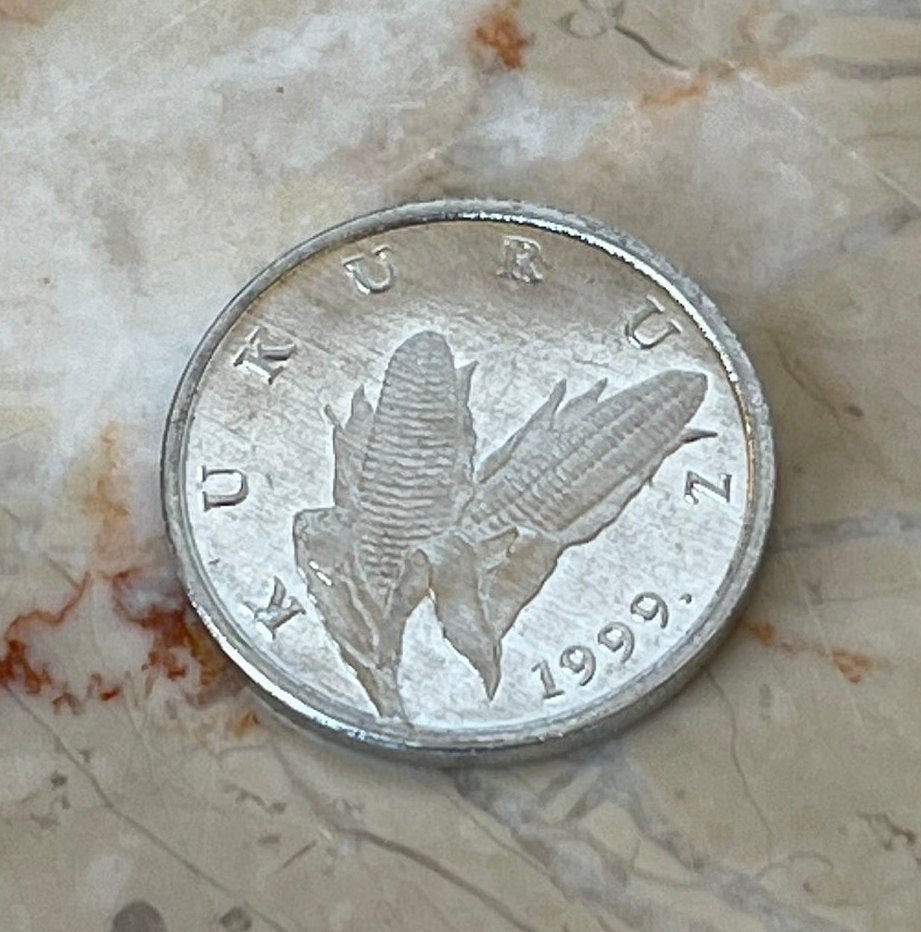elemintalshop
Ears of Corn 1 Lipa Croatia Authentic Coin Money for Jewelry and Craft Making (Linden Tree)
Ears of Corn 1 Lipa Croatia Authentic Coin Money for Jewelry and Craft Making (Linden Tree)
Couldn't load pickup availability
Ears of Corn 1 Lipa Croatia Authentic Coin Charm for Jewelry and Craft Making (Linden Tree)
Obverse
A stylized top of corn stalk with two ears in the center with a leaf of the left piston stamped initials of the author's visual design (KK) to the left and the word "corn" in Croatian to the left around the edge and the date in the middle of the bottom of the coin
Lettering: KUKURUZ
Translation: Corn
Reverse: A stylized branch of linden in inflorescence in the center and the value in numerals on the leaves and the word "LIPA" below. The arms of Croatia are in the middle of the bottom of the coin with the country name starting to the left going around the rim ending on the right of the coat of arms
Lettering:
REPUBLIKA HRVATSKA; 1 LIPA
Translation: Republic of Croatia
1 Lipa
Comments: The engraver of the coin, Kuzma Kovačić, was a distinguished Croatian academic sculptor.
Features
Issuer Croatia
Period Republic (1991-date)
Type Standard circulation coin
Years 1993-2019
Value 1 Lipa
0.01 HRK = 0.0015 USD
Currency Kuna (1994-date)
Composition Aluminium-magnesium (98% Aluminum, 2% Magnesium)
Weight 0.7 g
Diameter 17 mm
Thickness 1.4 mm
Shape Round
Orientation Medal alignment ↑↑
Number N# 2490
References KM# 3, Schön# 7
Wikipedia:
Maize has been an essential crop in the Andes since the pre-Columbian era. The Moche culture from Northern Peru made ceramics from earth, water, and fire. This pottery was a sacred substance, formed in significant shapes and used to represent important themes. Maize was represented anthropomorphically as well as naturally.
In the United States, maize ears along with tobacco leaves are carved into the capitals of columns in the United States Capitol building. Maize itself is sometimes used for temporary architectural detailing when the intent is to celebrate the fall season, local agricultural productivity and culture. Bundles of dried maize stalks are often displayed along with pumpkins, gourds and straw in autumnal displays outside homes and businesses. A well-known example of architectural use is the Corn Palace in Mitchell, South Dakota, which uses cobs and ears of colored maize to implement a mural design that is recycled annually. Another well-known example is the Field of Corn sculpture in Dublin, Ohio, where hundreds of concrete ears of corn stand in a grassy field.
A maize stalk with two ripe ears is depicted on the reverse of the Croatian 1 lipa coin, minted since 1993.
*************
Croatia (/kroʊˈeɪʃə/ kroh-AY-shə; Croatian: Hrvatska, pronounced [xř̩ʋaːtskaː]), officially the Republic of Croatia (Croatian: Republika Hrvatska), is a country at the crossroads of Central and Southeast Europe on the Adriatic Sea. It borders Slovenia to the northwest, Hungary to the northeast, Serbia to the east, Bosnia and Herzegovina and Montenegro to the southeast, and shares a maritime border with Italy to the west and southwest. Its capital and largest city, Zagreb, forms one of the country's primary subdivisions, with twenty counties. Croatia has 56,594 square kilometres (21,851 square miles) and a population of 4.07 million.
The Croats arrived in the 6th century and organised the territory into two duchies by the 9th century. Croatia was first internationally recognised as independent on 7 June 879 during the reign of Duke Branimir. Tomislav became the first king by 925, elevating Croatia to the status of a kingdom. During the succession crisis after the Trpimirović dynasty ended, Croatia entered a personal union with Hungary in 1102. In 1527, faced with Ottoman conquest, the Croatian Parliament elected Ferdinand I of Austria to the Croatian throne. In October 1918, the State of Slovenes, Croats and Serbs, independent from Austria-Hungary, was proclaimed in Zagreb, and in December 1918, merged into the Kingdom of Yugoslavia. Following the Axis invasion of Yugoslavia in April 1941, most of Croatia was incorporated into a Nazi installed puppet state, the Independent State of Croatia. A resistance movement led to the creation of the Socialist Republic of Croatia, which after the war became a founding member and constituent of the Socialist Federal Republic of Yugoslavia. On 25 June 1991, Croatia declared independence, and the War of Independence was fought for four years following the declaration.
A sovereign state, Croatia is a republic governed under a parliamentary system. It is a member of the European Union, the United Nations, the Council of Europe, NATO, the World Trade Organization, and a founding member of the Union for the Mediterranean. An active participant in United Nations peacekeeping, Croatia has contributed troops to the International Security Assistance Force and took a nonpermanent seat on the United Nations Security Council for the 2008–2009 term. Since 2000, the Croatian government has invested in infrastructure, especially transport routes and facilities along the Pan-European corridors.
Croatia is classified by the World Bank as a high-income economy and ranks very high on the Human Development Index. Service, industrial sectors, and agriculture dominate the economy, respectively. Tourism is a significant source of revenue, with Croatia ranked among the 20 most popular tourist destinations. The state controls a part of the economy, with substantial government expenditure. The European Union is Croatia's most important trading partner. Croatia provides social security, universal health care, and tuition-free primary and secondary education while supporting culture through public institutions and corporate investments in media and publishing.
Share










Very nice coins! So glad to have these in my collection now!!
5 stars review from Joakool
Really beautiful and very well packaged. Thank you so much.









